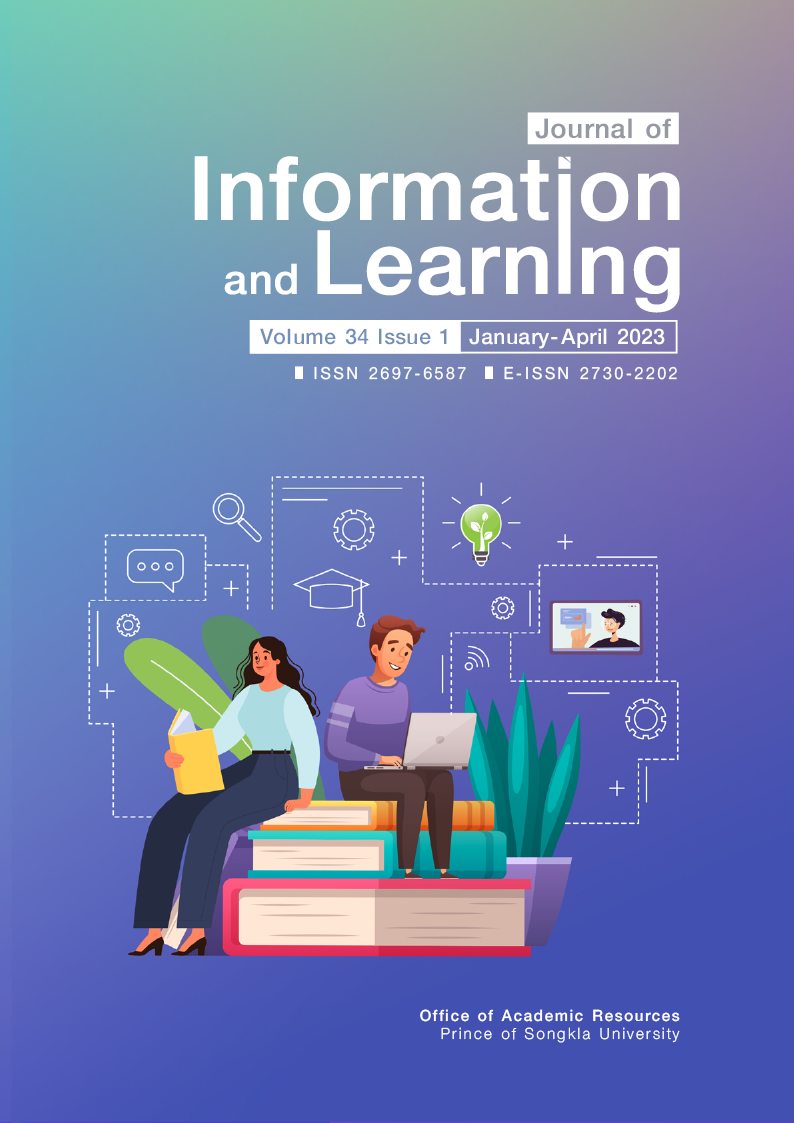Development of E-learning Courseware to Enhance English Writing Skills during the COVID-19 Pandemic
Main Article Content
Abstract
The objectives of this research were 1) to develop e-learning courseware to support English writing skills of undergraduate students, 2) to study students’ writing ability after using the e-learning courseware and the use of e-learning courseware by teachers and students, and 3) to study their satisfaction with the e-learning courseware. By means of random sampling, the sample was 233 undergraduate students and six teachers from six universities. The research tools were the e-learning courseware supporting English writing skills, the pre-test and post-test, and the e-learning courseware satisfaction questionnaire and in-depth interview questions. A pair simple t-test was used to assess the significance between students' pre-test and post-test results. Descriptive statistics (mean and SD) were generated from the participants' responses to a questionnaire to investigate their attitudes toward the e-learning courseware. Meanwhile, descriptive analysis was performed to investigate how the participants use the e-learning courseware. The findings revealed that the e-learning courseware was significantly effective and had a significant influence on English writing skill, as evidenced by the mean score of the post-test total score of 16.04 with a standard deviation of 1.95, which was significantly higher than the pre-test total score (a mean score of 11.21 with a standard deviation of 1.76) at t = 87.63, p < 0.05. Additionally, the data indicated that all teachers strongly liked the e-learning courseware in all aspects: content, teaching and learning, and the design of the teaching and learning system with an average score of 3.84. According to the ratings from the students, the e-learning courseware received high ratings for both its content and design system, with an average score of 3.86.
Article Details

This work is licensed under a Creative Commons Attribution-NonCommercial-NoDerivatives 4.0 International License.
The Journal of Information and Learning is operated by the Office of Academic Resources, Prince of Songkla University. All articles published in the journal are protected by Thailand copyright law. This copyright covers the exclusive rights to share, reproduce and distribute the article, including in electronic forms, reprints, translations, photographic reproductions, or similar. Authors own copyrights in the works they have created as well as the Office of Academic Resources. The Journal reserves the right to edit the language of papers accepted for publication for clarity and correctness, as well as to make formal changes to ensure compliance with the journal's guidelines. All authors must take public responsibility for the content of their paper.
References
Eldredge, J. (1995). Teaching decoding in holistic classrooms. Merrill/MacMillan.
Hedge, T. (1998). Writing. Oxford University Press.
Hughey, J. B., Wormuth, D. R., Hartfiel, V. F., & Jacobs, H. L. (1983). Teaching ESL composition: Principles and techniques. Newbury House Publishers.
Jitbunyapinit, C., & Praneetpolgrang, P. (2016). Effects learning and educational achievement in the development of teaching and learning using e-learning in information technology course for students in Mathayomsuksa 1 [Conference Sesession]. National and International Sripatum Univer-sity Conference 2016. Bangkok, Thailand. http://bit.ly/3xw9A3M
Kankaew, K., & Suksudthi, T. (2021). Slide-topology: The traditional presentation versus infographic for the new generations online learning. Elementary Education Online, 20(5), 930-935. https://doi.org/10.17051/ilkonline.2021.05.100
Levy, Y. (2003). A study of learners perceived value and satisfaction for implied effectiveness of online learning systems [Doctoral dissertation, Florida International University]. ProQuest Disserta-tions Publishing. https://www.proquest.com/docview/305232047
Lunsford, A. A., & Connors, R. J. (1992) Exercising demonolatry: Spelling patterns and pedagogies in college writing. Written Communication, 9(3), 404-428. https://doi.org/10.1177/0741088392009003004
Lupkosa, S. (2010). The development of English writing skills of the tenth grade students using task-based activities [Unpublished Master's thesis]. Mhasarakham University.
Luthra, P., & Mackenzie, S. (2020). 4 ways COVID-19 could change how we educate future gener-ation. World Economic Forum. https://www.weforum.org/agenda/2020/03/4-ways-covid-19-education-future-generations/
Meesri, S. (2016). Development of English writing exercises focusing on genre-based approach for Mathayomsuksa sixth students at Sriwichaiwithaya School, Nakhon Pathom [Master Thesis, Silapa-korn University]. DSpace at Silpakorn University. http://202.44.135.157/dspace/bitstream/123456789/1369/1/55254326.pdf
Shafiee, S., Kosha, M., & Afghari, A. (2013). The effect of conventional, web-based, and hybrid teaching of pre-writing strategies on Iranian EFL learners’ writing performance. International Re-search Journal of Applied and Basic Sciences, 4(2), 393-401. https://www.yumpu.com/en/document/read/50777849/the-effect-of-conventional-web-based-and-hybrid-teaching-of-pre/
Tachel, T., Buseyne, S., & Everaerts, P. (2015). Introduction and development of active learning with ICT with the opportunities of e-learning [Conference session]. E-Learn: World Conference on E-Learning in Corporate, Government, Healthcare, and Higher Education, Hawaii, United States. http://www.learntechlib.org/p/151986
Tantayanusorn, S., & Sermsongsawat, A. (2011). Development of English writing skill teaching model for lower secondary students. Journal of Human Sciences, Faculty of Humanities, Chiang Mai University, 12(1), 57-67.
Tilawat. N. (2004). The development of English writing skills of the twelfth-grade students Using the writing process approach [Unpublished Master Thesis]. Srinakharinwirot University.
Tipsuk, T. (2009) The development of learning outcomes on English reading and writing commu-nication of the ninth-grade student using the CIRC technique. [Master Thesis, Silapakorn Universi-ty]. SURE. http://sure.su.ac.th/xmlui/handle/123456789/7507?attempt=2&
Winthrop, R. (2020). Global economy and development: Top 10 risks and opportunities for educa-tion in the face of COVID-19. Education Plus Development. https://www.brookings.edu/blog/education-plusdevelopment/2020/04/10/top-10-risks-and-opportunities-for-education-in-the-face-of-covid-19/
Yucel, S. (2006). E-learning approach in teacher training. Turkish Online Journal of Distance Educa-tion-TOJDE, 7(4), 1-8. https://files.eric.ed.gov/fulltext/ED494378.pdf


